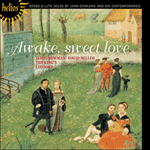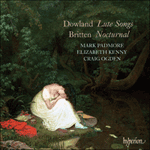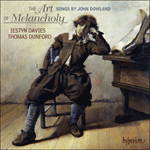
Welcome to Hyperion Records, an independent British classical label devoted to presenting high-quality recordings of music of all styles and from all periods from the twelfth century to the twenty-first.
Hyperion offers both CDs, and downloads in a number of formats. The site is also available in several languages.
Please use the dropdown buttons to set your preferred options, or use the checkbox to accept the defaults.

from notes by Elizabeth Kenny © 2008
extrait des notes rédigées par Elizabeth Kenny © 2008
Français: Hypérion
aus dem Begleittext von Elizabeth Kenny © 2008
Deutsch: Elke Hockings
 Dowland: Awake, sweet love Dowland: Awake, sweet love‘Restores a dimension of beauty that is often sacrificed in present day performances … Happy the family that spent its leisure hours with this mu ... ‘James Bowman’s usual ease of tone is in full evidence here. He gives us meltingly sweet, gorgeous, resonant high notes, and fluidity of vocal line. M ...» More |
 Dowland: Lute Songs; Britten: Nocturnal Dowland: Lute Songs; Britten: NocturnalMark Padmore is widely acknowledged as one of the greatest tenors working today. He is admired—among other things—for his ‘extraordinary diction and whispering chamber-like intimacy … [his] joy in conveying the emotional core of each situation’ (Gra ...» More |
 Dowland: The Art of Melancholy Dowland: The Art of MelancholyThe marriage of music and poetry and the extraordinary writing for both lute and voice combine to proclaim Dowland as the father of English song. Countertenor Iestyn Davies has gained international fame through his operatic performances (including ...» More |

